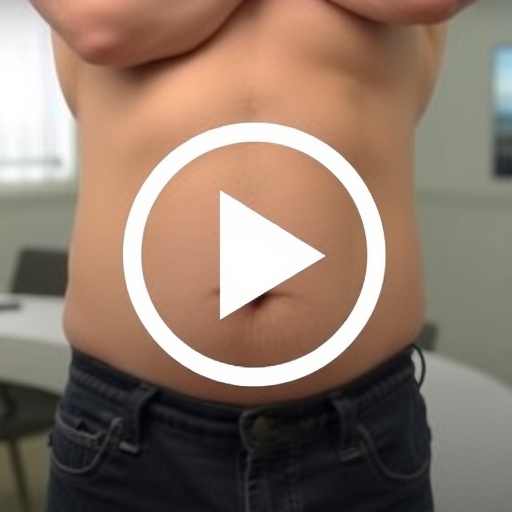In a groundbreaking advancement poised to transform pediatric emergency care awareness, a recent study highlights the remarkable impact of an educational video designed explicitly to enhance understanding and timely recognition of testicular torsion among patients and their caregivers. Testicular torsion, a urological emergency characterized by the twisting of the spermatic cord, leads to the cessation of blood flow to the testicle, necessitating immediate surgical intervention to prevent irreversible damage. The study’s innovative approach to public health education addresses a long-standing challenge in pediatric urology: the under-recognition of this condition by non-medical individuals, which can critically delay treatment and result in significant morbidity.
The educational video at the heart of this research exemplifies the strategic utilization of multimedia tools to disseminate complex medical information effectively across diverse demographic groups. Testicular torsion’s symptomatology, often confused with less severe conditions such as epididymitis or orchitis, demands a differential diagnostic awareness that the general population rarely possesses. By employing clear visual and verbal cues, the video demystifies these symptoms, illustrating the urgency and typical presentation of torsion – sudden onset of severe scrotal pain, swelling, nausea, and abdominal discomfort – factors that mandate immediate medical consultation.
Crucially, the implementation of this video harnesses behavioral science principles to foster proactive healthcare seeking behaviors. The researchers meticulously crafted the content to not only inform but also engage viewers emotionally and cognitively, thereby enhancing knowledge retention and prompt decision-making. This aligns with contemporary educational models emphasizing interactive and emotionally resonant learning, recognizing that comprehension alone does not translate into action without affective engagement.
The study deployed a controlled trial methodology across various pediatric outpatient and emergency departments, enrolling a heterogeneous cohort of patients and caregivers to assess baseline awareness levels and subsequent knowledge gains post-exposure to the video. Pre- and post-intervention assessments employed validated questionnaires critically evaluating recognition of clinical signs, urgency perception, and intended actions in suspected torsion scenarios. The findings reveal a statistically significant increase in awareness scores among both patients and caregivers, underscoring the medium’s efficacy in bridging the knowledge gap.
Beyond quantitative improvements, qualitative data collected through interviews and focus groups illustrate profound shifts in attitudes toward testicular health and emergency responsiveness. Participants expressed heightened confidence in recognizing alarming symptoms and disclosed intentions to seek immediate care rather than employing watchful waiting or home remedies. These attitudinal changes suggest that the video transcends mere information delivery, instilling a sense of agency and urgency crucial in time-sensitive conditions like testicular torsion.
From a pathophysiological perspective, the urgency in diagnosing and managing testicular torsion cannot be overstated. With ischemia-induced testicular necrosis occurring rapidly—often within six hours from symptom onset—the time window for salvaging the affected testicle is narrow. Delays in presentation frequently culminate in orchiectomy, with significant consequences including fertility impairment and psychological distress. The study’s educational intervention directly addresses this critical temporal factor by empowering laypersons with the competence to distinguish torsion from benign mimics, thus potentially reducing the incidence of adverse outcomes.
Technical aspects of the video production warrant attention due to their sophisticated incorporation of medical imagery employing computer-generated simulations. These visualizations elucidate the anatomical structures involved in torsion, depicting the twisting phenomenon and subsequent vascular compromise in an accessible fashion. This use of dynamic, high-definition imagery facilitates conceptual understanding among audiences without medical backgrounds, overcoming common barriers posed by anatomical complexity and clinical jargon.
Furthermore, the video integrates evidence-based protocols regarding immediate steps upon suspecting torsion, including the necessity of abstaining from self-manipulation attempts and the imperative of urgent emergency room evaluation. This instructional component aligns with clinical guidelines, reinforcing standardized patient pathways that optimize outcomes while minimizing unnecessary delays or complications.
The research also explored the video’s dissemination logistics, employing digital platforms such as hospital websites, social media channels, and direct patient education sessions. This multi-pronged strategy ensures broad accessibility, accommodating varying socioeconomic strata and technological literacy levels. Moreover, the digital format allows for ongoing content updates reflecting emerging clinical insights or feedback from recipients, underscoring the adaptability and sustainability of the intervention.
Importantly, the study situates the video within a comprehensive educational framework, recommending its integration into routine pediatric health maintenance visits and community health programs. By embedding this resource into established healthcare communication channels, practitioners can reinforce critical health messages systematically, contributing to a culture of informed vigilance around pediatric urological emergencies.
The implications of this research extend beyond testicular torsion alone, offering a replicable model for leveraging multimedia educational tools in diverse clinical contexts. The demonstrated success advocates for similar initiatives addressing other pediatric emergencies where early recognition and timely intervention drastically influence prognoses, such as appendicitis, intussusception, and severe asthma exacerbations.
In conclusion, the implementation of a targeted educational video represents a significant leap forward in patient-centered healthcare communication. By furnishing patients and caregivers with actionable knowledge about testicular torsion, this intervention fosters early symptom detection, expedites medical evaluation, and ultimately enhances clinical outcomes. The study exemplifies the synergistic potential of contemporary digital media applications and clinical expertise in improving pediatric emergency awareness and response, heralding a promising direction for future public health education efforts.
Subject of Research: Educational intervention to improve awareness of testicular torsion among patients and caregivers.
Article Title: Implementation of an educational video about testicular torsion improves patient and caregiver awareness.
Article References:
Abelson, B., Flores, V., Adams, C. et al. Implementation of an educational video about testicular torsion improves patient and caregiver awareness. Pediatr Res (2025). https://doi.org/10.1038/s41390-025-04463-6
Image Credits: AI Generated
DOI: https://doi.org/10.1038/s41390-025-04463-6
Tags: behavioral science in health educationcaregiver awareness of testicular conditionsdifferential diagnosis in urologyeducational video on testicular torsionenhancing patient education through videomultimedia tools in health educationpediatric emergency care awarenesspreventing testicular damagepublic health education strategiesrecognizing testicular torsion symptomsurgency of medical intervention for torsionurological emergencies in children





